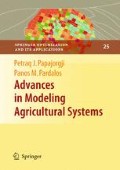Abstract
This work proposes an exercise-dependent real options model for the valuation and optimal harvest timing of a forestry investment in eucalyptus. Investment in eucalyptus is complex, as trees allow for two cuts without replantation and have a specific time and growth window in which they are suitable for industrial processing into paper pulp. Thus, path dependency in the cutting options is observed, as the moment of exercise of the first option determines the time interval in which the second option may be exercised. Therefore, the value of the second option depends on the history of the state variables rather than on its final value. In addition, the options to abandon the project or convert land to another use, are also considered. The option value is estimated by solving a stochastic dynamic programming model. Results are reported for a case study in the Portuguese eucalyptus forest, which show that price uncertainty postpones the optimal cutting decisions. Moreover, optimal harvesting policies deviate from current practice of forest managers and allow for considerable gains.
Access this chapter
Tax calculation will be finalised at checkout
Purchases are for personal use only
Notes
- 1.
An option is the right, but not the obligation, to take some action in the future under specified terms. A call option gives the holder the right to buy a stock at a specified future date (maturity) by a specified price (exercise or strike price). This option will be exercised (used) if the stock price on that date exceeds the exercise price.
- 2.
Any other value that could be obtained for the wood can be used in our model.
- 3.
The initial investment is considered to be given by the land acquisition costs, the plantation costs, and the cost of a maintenance contract for the full length of the project. However, this contract does not include cutting, peeling, and transportation of the harvested wood, which account for the exercise price of the cutting option.
- 4.
This value was obtained through the analysis of the operating costs of the paper pulpwood companies and their installed capacity, and also through inquiries to experts.
References
Abildtrup, J. & Strange, N. (1999), ‘The option value of non-contaminated forest watersheds,’ Forest Policy and Economics 1, 115–125.
Aliança Florestal (2002), Technical Internal Report: www.alflorestal.pt.
Arrow, K. & Fisher, A. C. (1974), ‘Environmental preservation, uncertainty and irreversibility,’ Quarterly Journal of Economics 88, 312–319.
Bailey, W. (1991), ‘Valuing agricultural firms: An examination of the contingent claims approach to pricing real assets,’ Journal of Economic Dynamics and Control 15, 771–791.
Black, F. & Scholes, M. (1973), ‘The pricing of options and corporate liabilities,’ Journal of Political Economy 27, 637–654.
Brennan, M. & Schwartz, E. (1985), ‘Evaluating natural resource investments,’ Journal of Business 58, 135–157.
CELPA (Associação da Indústria Papeleira) : www.celpa.pt.
Cox, J., Ross, S. & Rubinstein, M. (1979), ‘Option pricing: a simplified approach,’ Journal of Financial Economics 12, 229–263.
DGRF – Database (2001), Inventário Florestal Nacional by Direcção Geral dos Recursos Florestais: www.dgf.min-agricultura.pt.
Dixit, A. & Pindyck, R. S. (1994), Investment Under Uncertainty, Princeton University Press, Princeton, NJ.
Duku-Kaakyire, A. & Nanang, D. M. (2004), ‘Application of real options theory to forestry investment analysis,’ Forest Policy and Economics 6, 539–552.
FAO (Food and Agricultural Organization of the United Nations): www.fao.org.
Gjolberg, O. & Guttornmsen, A. G. (2002), ‘Real options in the forest: What if prices are mean reverting,’ Forest Policy and Economics 4, 13–20.
Henry, C. (1974), ‘Option values in the economics of irreplaceable assets,’ Review of Economic Studies 41, 89–104.
INE – Infoline (2001), Instituto Nacional de Estatística: www.ine.pt.
Insley, M. (2002), ‘A real options approach to the valuation of a forestry investment,’ Journal of Environmental Economics and Management 44, 471–492.
Insley, M. & Rollins, K. (2005), ‘On solving the multirotational timber harvesting problem with stochastic prices: a linear complementarity formulation,’ American Journal of Agricultural Economics 87, 735–755.
Malchow-Mollera, N., Strangeb, N. & Thorsen, B. J. (2004), ‘Real-options aspects of adjacency constraints,’ Forest Policy and Economics 6, 261–270.
Merton, R. C. (1973), ‘An intertemporal capital asset pricing model,’ Econometrica 41, 867–887.
Morck, R., Schwartz, E. & Stangeland, D. (1989), ‘The valuation of forestry resources under stochastic prices and inventories,’ Journal of Financial and Quantitative Analysis 24(4), 473–487.
Pindyck, R. S. (1991), ‘Irreversibility, uncertainty, and investment,’ Journal of Economic Literature 29(3), 1110–1148.
Portucel Setúbal (2002), Technical Internal Report: www.portucelsoporcel.com.
Reed, W. (1993), ‘The decision to conserve or harvest old-growth forest,’ Ecological Economics 8, 45–49.
Robichek, A. A. & Myers, S. (1966), ‘Conceptual problems in the use of risk-adjusted discount rates,’ Journal of Finance 21, 727–730.
Sharpe, W. F. (1964), ‘Capital asset prices: A theory of market equilibrium under conditions of risk,’ Journal of Finance 19(3), 425–442.
Thomson, T. A. (1992), ‘Option pricing and timberlands land-use conversion option: comment,’ Land Economics 68, 462–469.
Tomé, M., Ribeiro, F. & Soares, P. (2001), O modelo glóbulus 2.1, Technical report, Grupo de Inventariação e Modelação de Recursos Naturais, Departamento de Engenharia Florestal, Instituto Superior de Agronomia, Universidade Técnica de Lisboa.
Wilmott, P. (1998), Derivatives, the Theory and Practice of Financial Engineering, Wiley, Chickester, UK.
Yin, R. (2001), ‘Combining forest-level analysis with options valuation approach – a new framework for assessing forestry investment,’ Forest Science 47(4), 475–483.
Zinkhan, F. (1991), ‘Option pricing and timberlands land-use conversion option,’ Land Economics 67, 317–325.
Acknowledgments
The authors would like to thank FCT for the financial support through scholarship BD/12610/03 and project POCI/MAT/61842/04.
Author information
Authors and Affiliations
Corresponding author
Appendices
Appendix A
Appendix B
Rights and permissions
Copyright information
© 2009 Springer Science+Business Media, LLC
About this chapter
Cite this chapter
Cunha, M.R., Fontes, D.B.M.M. (2009). A Stochastic Dynamic Programming Model for Valuing a Eucalyptus Investment. In: Advances in Modeling Agricultural Systems. Springer Optimization and Its Applications, vol 25. Springer, Boston, MA. https://doi.org/10.1007/978-0-387-75181-8_16
Download citation
DOI: https://doi.org/10.1007/978-0-387-75181-8_16
Published:
Publisher Name: Springer, Boston, MA
Print ISBN: 978-0-387-75180-1
Online ISBN: 978-0-387-75181-8
eBook Packages: Mathematics and StatisticsMathematics and Statistics (R0)

